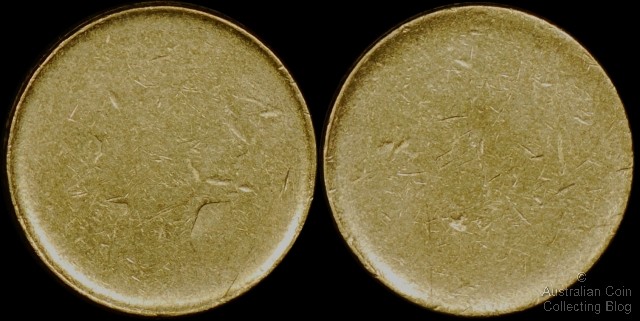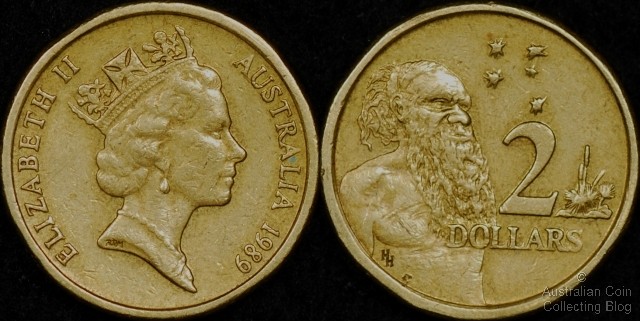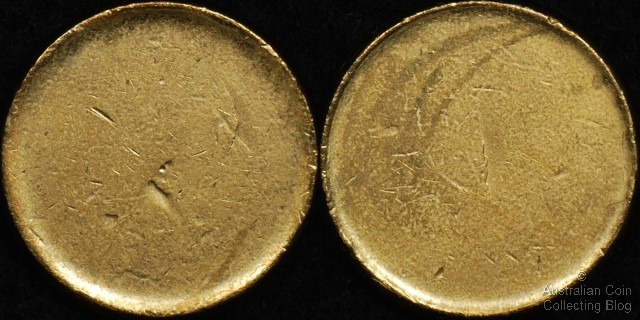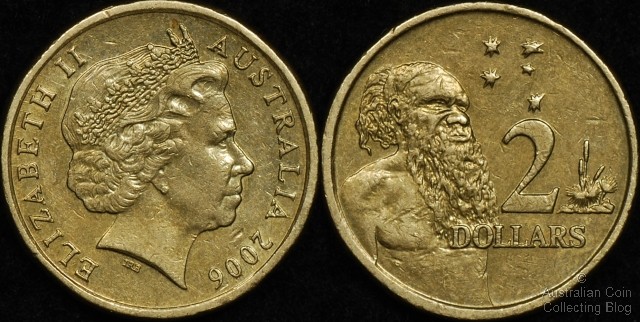

Australian $2 Die Adjustment Strike Error 1
Above you can see a very weakly struck Australian $2 coin and below it, a properly struck $2 coin of the same era. You'll note that the barest impression of the Queen's portrait is visible on the error coin and just a couple of design elements are visible on the reverse design. The portrait we can see is that sculpted by Raphael Maklouf, so this error was minted sometime from 1988 to 1998.
This is coin is an error which is commonly known as a 'die adjustment strike' error coin. Theory has it that these coins are produced by the operators of the minting presses who are running various trials and strike coins at different operating pressures, perhaps to determine the ideal striking pressure of the coin press or for some other reason. Die adjustment strike errors can occur with varying degrees of strike weakness and the one shown above is clearly at the bottom end of the scale as the coin has barely been struck at all! It's worth having a quick look at another Die Adjustment Strike error before we discuss why these errors are due to a low striking pressure rather than being struck through oil.


Australian $2 Die Adjustment Strike Error 2
The above Die Adjustment Strike error shows just the faintest trace of the Ian Rank-Broadley portrait of Her Majesty. This coin was (only barely) struck sometime between 1999 and the present day.
So, how can we tell these errors are extremely weak strikes rather than a filled die or perhaps a sanded down coin? There are several distinguishing characteristics:
- The coin mass is correct (an Australian $2 coin should weigh 6.60g, the above coins weigh 6.53 and 6.58g respectively).
- The diameter of the coins is slightly smaller than their fully struck counterparts. The implies that the coin has not 'spread' as much due to the lower striking pressure. The above coins both measure a fraction under 20mm in diameter where as a fully struck $2 coin measures in at 20.6mm.
- There is no reeding present on the edges of the coin. The reeding is applied by the fixed collar die, and relies on the striking pressure to expand the coin sufficiently to press against the collar die and apply the reeding. This has not happened.
- The rims are not fully formed. The rims on a properly struck $2 coin are wide and flat. The die adjustment strike errors show the typical shallow rims that were applied to the blank by an upsetting mill before being struck.
Authors Note
While these errors are commonly referred to as "die adjustment strike errors" we believe that there's a very good possibility that they are in fact just very weak strikes due to press malfunctions. One would imagine that coins struck from trials would be jealously guarded and unlikely to escape the mint. It seems more likely that high speed presses striking hundreds of coins a minute could experience occasional malfunctions due to pneumatic or hydraulic blockages and this would result in the full striking pressure not being applied to one or more coins. The idea that coins struck during these failures could escape the mint seems entirely more plausible than test strikes escaping the eyes of vigilant press operators.
Posted by mnemtsas at March 23, 2011 4:33 PM
Subscribe to our Newsletter


